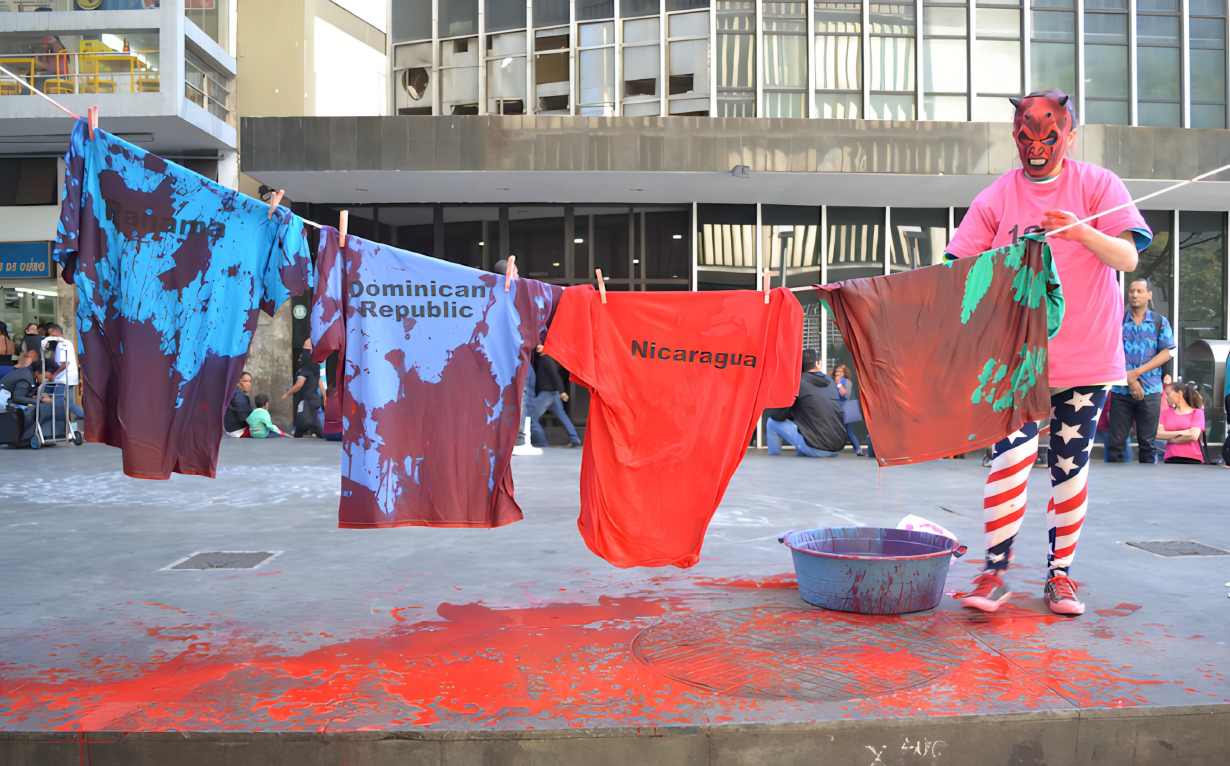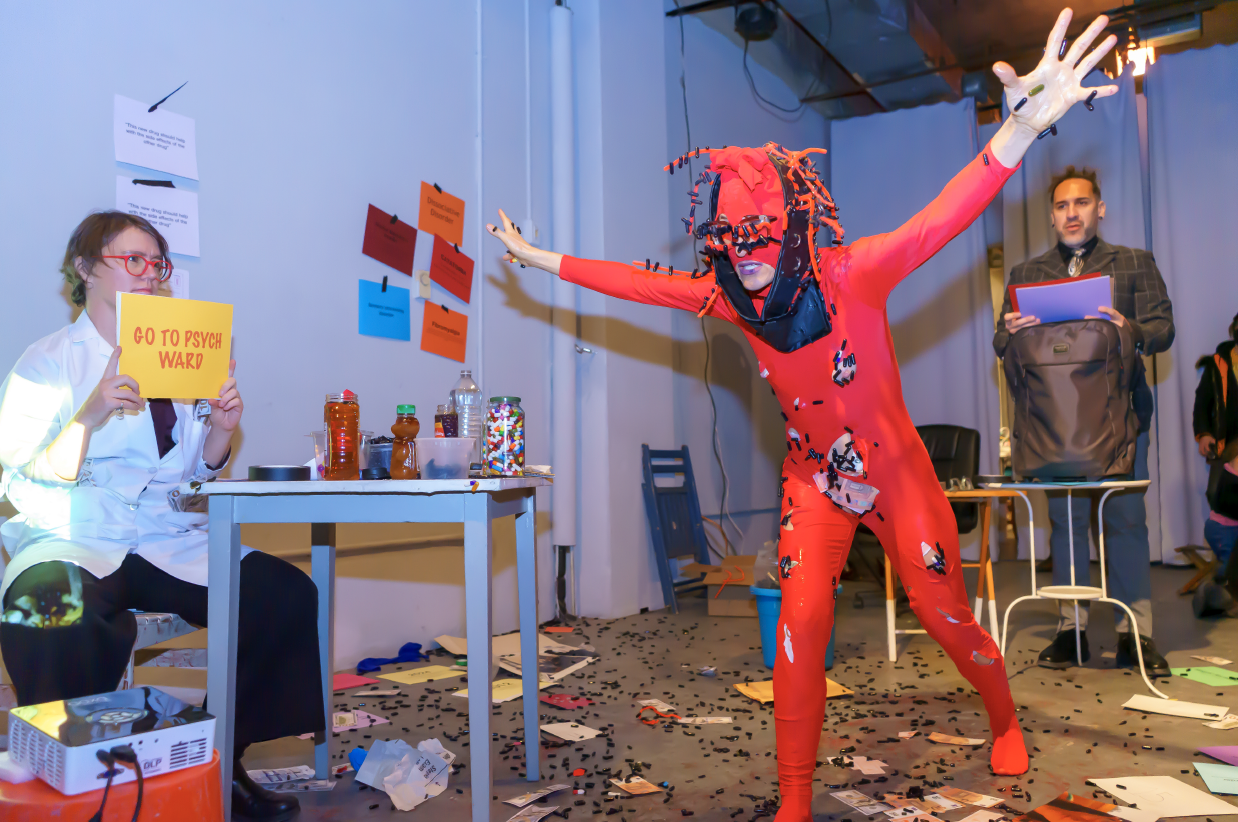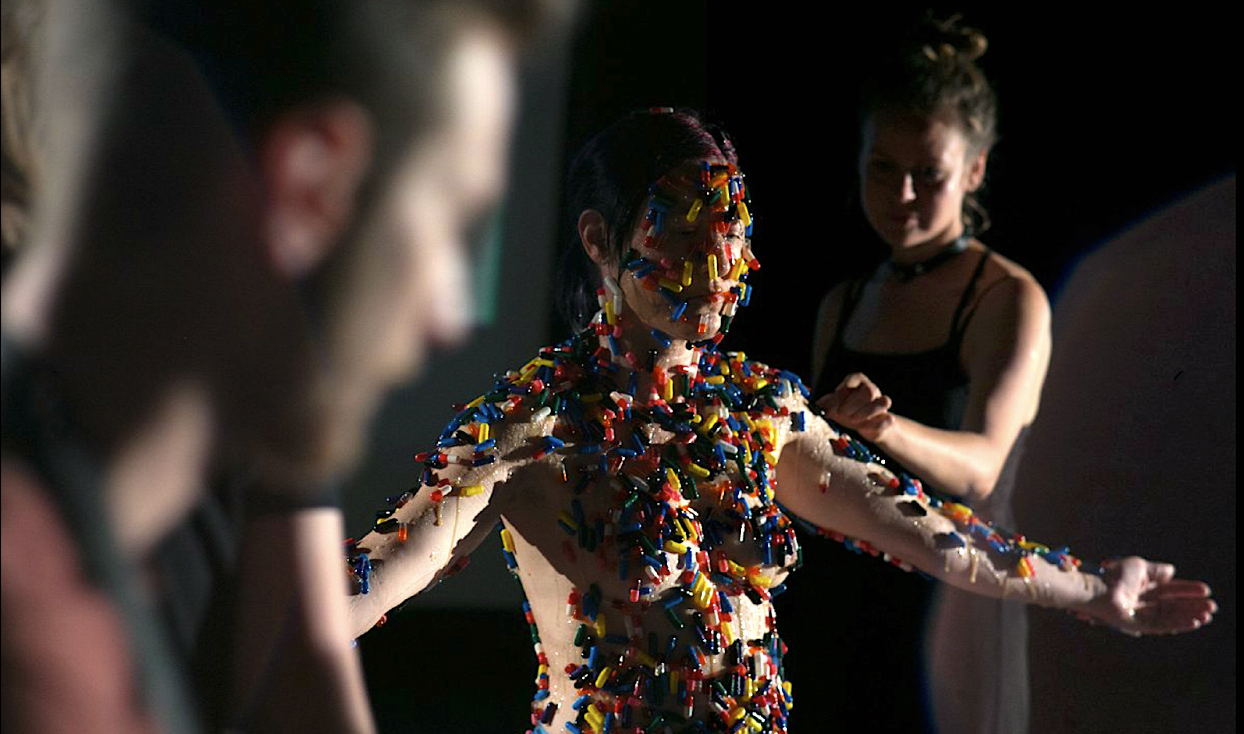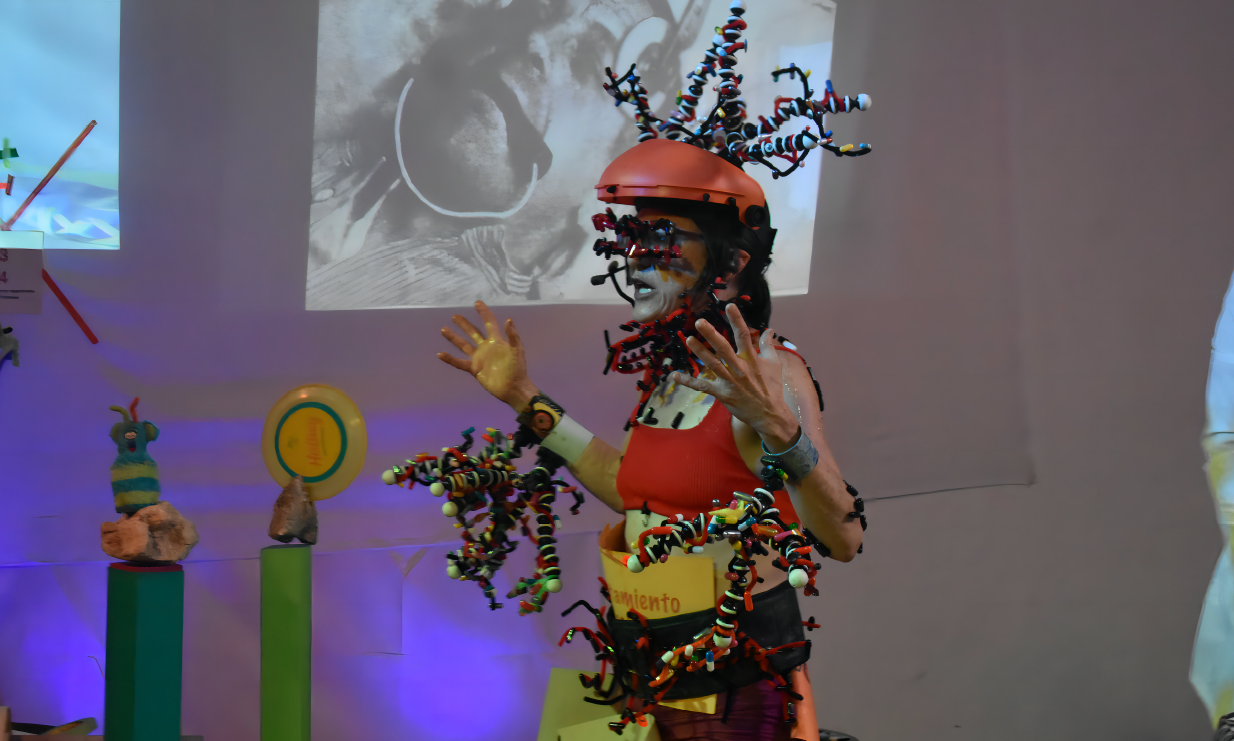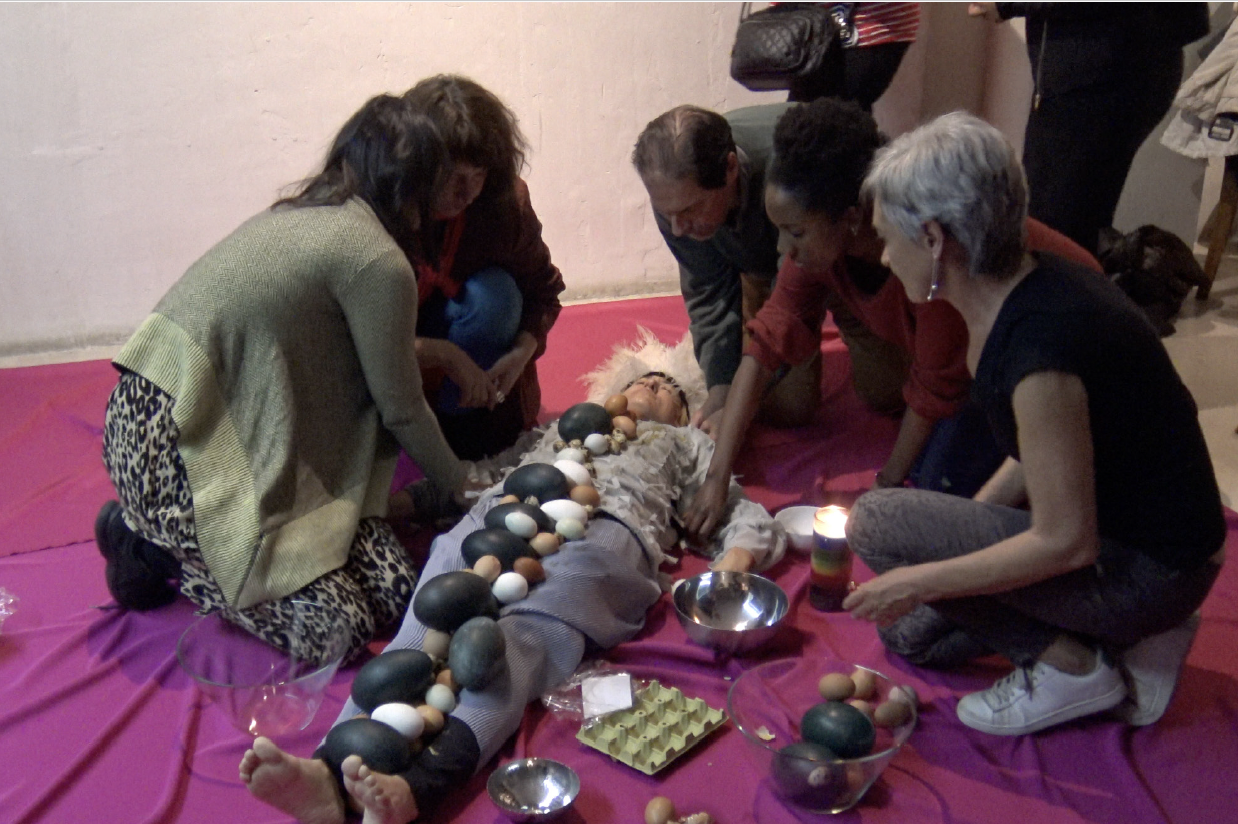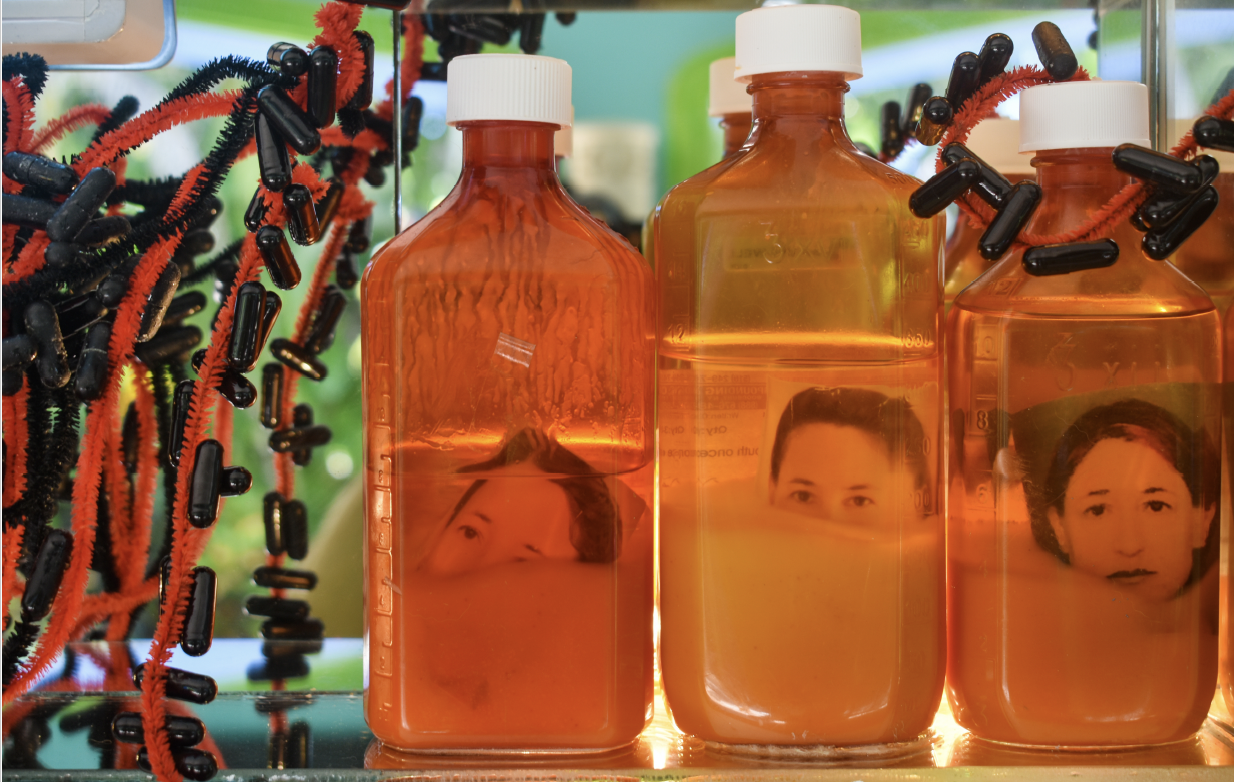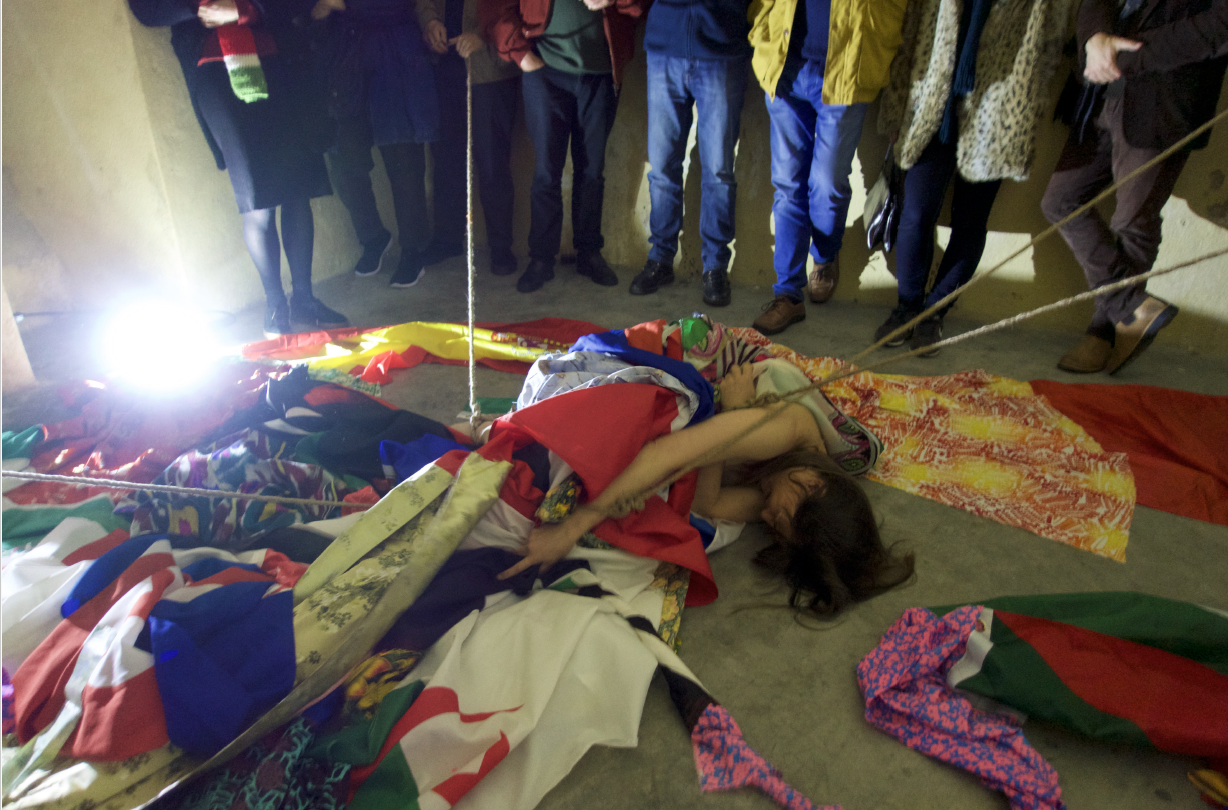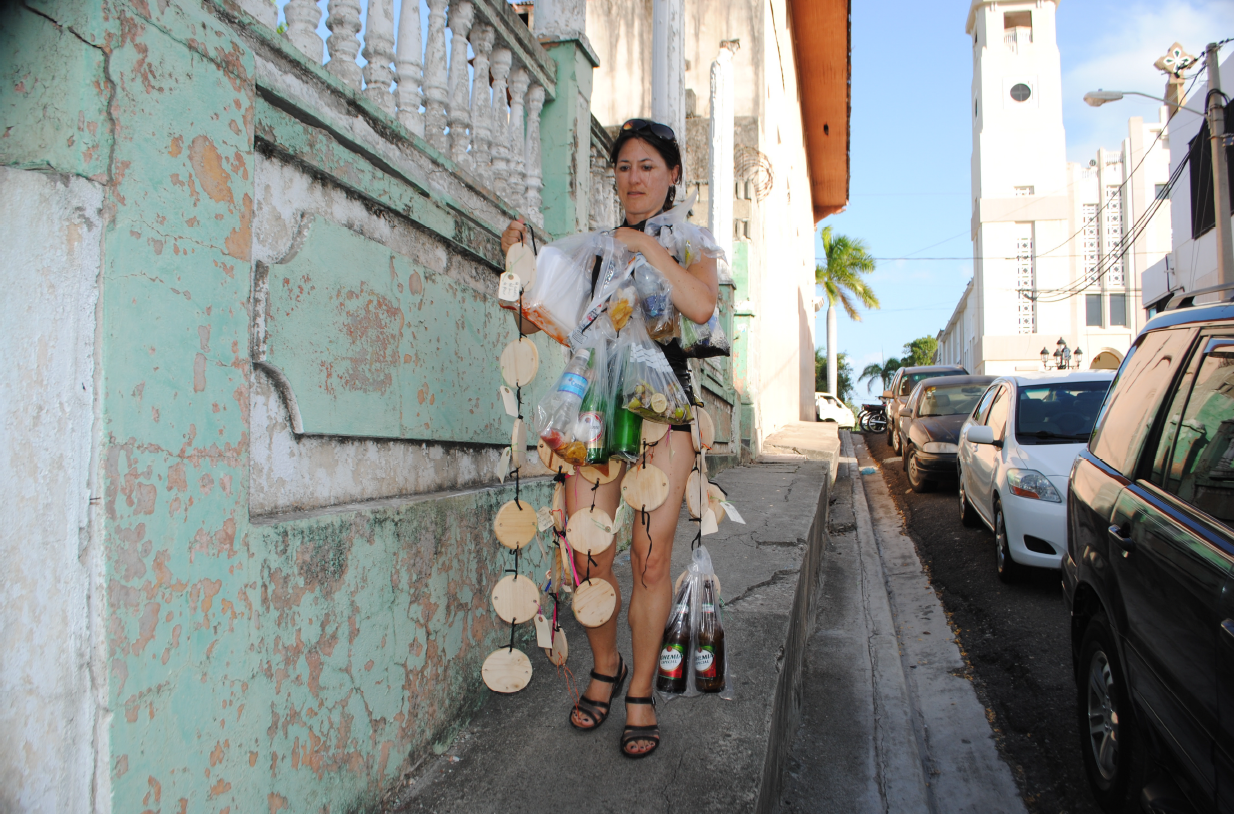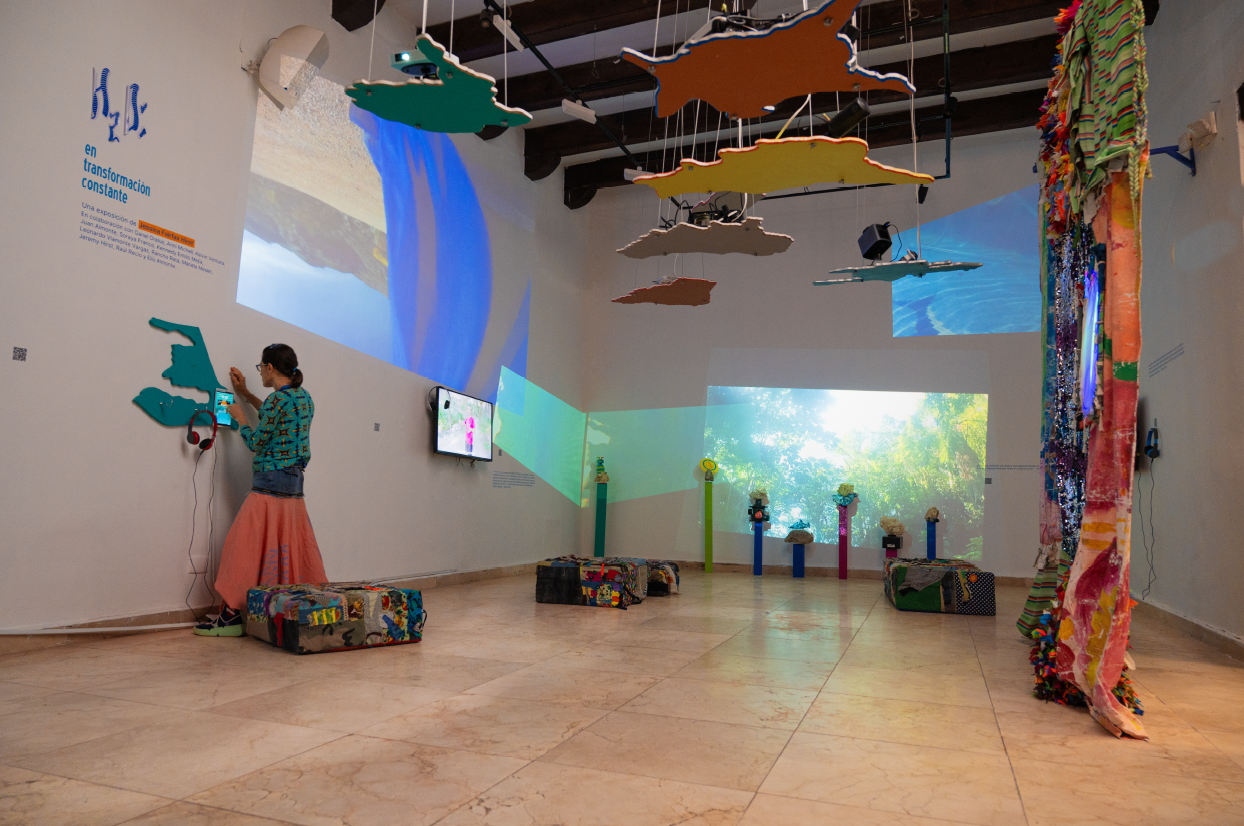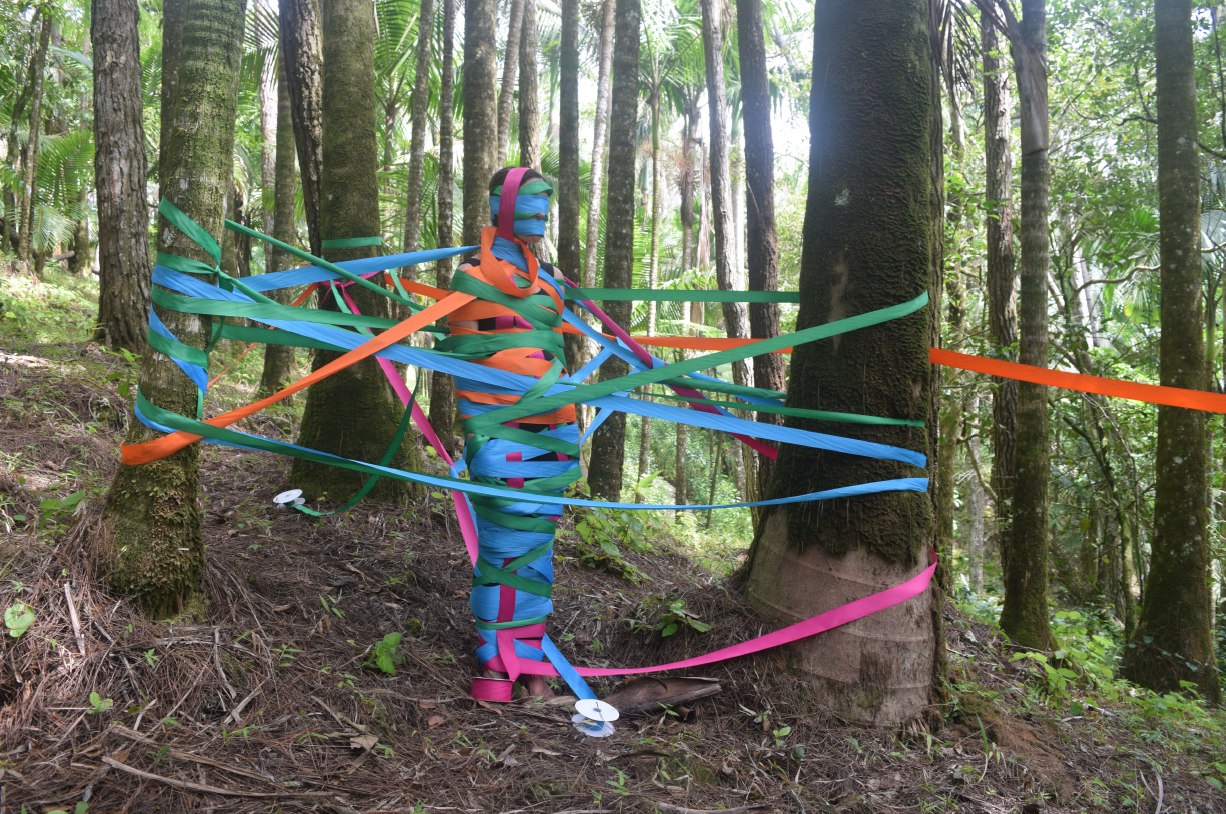Jessica Fairfax Hirst
Nicolás Dumit Estévez Raful Espejo Ovalles Morel: Jessica, we had the pleasure of meeting in person in Cabarete, where you now reside. How did you arrive in the Dominican Republic, where I was born, and what keeps you there? I am asking because I understand that you have been traveling around the globe for decades, while I left the Dominican Republic 35 years ago, and I have lived longer in the US than in the island. Home for me is the South Bronx.
Jessica Fairfax Hirst: The short answer is that I arrived in the Dominican Republic because I was invited by Eliu Almonte to participate in Performatorio, a festival of durational performance art in Puerto Plata, in 2012. Charo Oquet had invited me to participate in her performance festival in Miami earlier in 2012, and it was there that I was introduced by Charo to Eliu and an exciting group of Dominican performance artists, including Jochi Muñoz, and Grimaldy Polanco.
There is a much longer answer, related to how certain aspects of US culture became untenable for me. I made a short film in 2020 that tells the story, Beyond the Binaries, which weaves this tale in and out of lessons I have learned in ecology, philosophy, and theory.
I grew up near Washington DC in a mixed Protestant and Jewish white family with a lot of privilege and a lot of internalized expectations that I must do something extraordinary to contribute to the world. I studied environmental science and policy at Stanford, and I went to work in the White House office of Environmental Policy, where I was an assistant in the production of the first US National Climate Change Action Plan in 1993-94. I moved to the Department of Energy, where I worked on an international pilot program on what we now call carbon credits. I started my masters at UC Berkeley, and then I took time off for a fellowship at the University of Cape Town, where I was doing research and served as a consultant for the South African National Climate Change Committee.
While I was there, I decided that as a reasonably successful and stable adult, I no longer needed to take an antidepressant. I followed my doctor’s instructions to cut the dose in half, and then in half again, and within a couple of weeks I was off the medication. I entered into traumatic withdrawal from the antidepressant, but in the late ‘90s doctors didn’t recognize it as such, and I started to accumulate a growing list of additional diagnoses, and many more prescriptions for medications. I could not get better in the United States. I was very depressed, anguished, and ashamed for years that I was disabled and could no longer work on climate change policy. Whenever I would meet new people in the DC area, their first question to me would be “so what do you do for a living?” And because I did not have an impressive answer, I felt devastated, and spent years wanting to be hit by a truck.
It wasn’t until I went into another downward spiral in 2005-2006 and was fired from all of my jobs teaching dance that on a whim I decided to move to Nicaragua. Being there, nobody asked me what I did for a living. I finally had the mental space to explore who I might be if I wasn’t going to be a high-powered climate change policy person. So the answer of what keeps me in the Dominican Republic is partly an answer in the negative— I cannot live in the United States without becoming incredibly ill and disabled. I moved away from the Dominican Republic in 2016 to study in the social practice MFA at Otis College of Art and Design in Los Angeles. I had to drop out in 2018 because being there made me seriously ill again.
There are a lot of positive things that keep me in the Dominican Republic. I met and fell in love with my now husband, Eliu Almonte, and I also met and fell in love with the collective of performance artists that were based in Puerto Plata and organizing multiple festivals each year. They invited me to join them, and together we produced multiple performance art festivals, and exhibitions. Right now, I have two pieces in the Dominican Bienal Nacional de Artes Visuales at the Museo de Arte Moderno in Santo Domingo, one of which was awarded a prize by the jury. The Dominican art community has given me so many opportunities to contribute, participate, perform and exhibit. As I told you during our visit, I rarely apply for art opportunities in the United States, because it seems almost impossible to be accepted without an art degree, never mind that the reason I couldn’t finish my MFA had to do with institutional ableism and my own disability and illness rather than lack of ability in art.
NDEREOM: That is a question that makes me cringe: What do you do for a living? As if my job/work is what determines who I am. It is a question that is common in the US, and especially in some New York City circles. It is a passive aggressive way of placing the person asked within a class bracket, and maybe even trying to determine how accomplished that person is, and what can I get from them. It is transactional in nature. But, you started as an eco-activist working with Al Gore, and you even went to meet the Clintons. What prompted you to become a performance artist? Would you consider yourself an artivist or do you navigate these two fields as interconnected yet separate worlds? Tell me.
JFH: To be fair, I was very Junior when I was working in Washington. I only met Al Gore and President Clinton in person a couple of times.
How did I become a performance artist?
I would say that I became a Performance artist by instinct, as a survival mechanism. During my very dark years of anguish due to protracted withdrawal, my body and spirit only came alive while I was dancing. Dance had always been my outlet from the stress of other academics and work, and in the 2000s it became my profession. I was a teacher, member of several dance companies, both contemporary dance and hip-hop, and I cofounded a dance company called Catscratch Theatre in Washington DC. We worked in structured improvisation, often in relationship to architectures such as the Washington DC underground train system. I think that this work with Catscratch laid the groundwork for me to start working in Performance. When I began to choreograph my own work, the somewhat conservative dance community in DC sometimes told me that what I was doing wasn’t actually “dance.”
When I moved to Managua, Nicaragua, in 2006, there were no sprung wooden dance floors. There were only very hard concrete floors, and my joints couldn’t take it. Daniel Ortega had just returned to the presidency, and began attacking reproductive and other rights. I started working with the feminist movement, and created interventions and performative installations. It wasn’t until I went to the Metáfora Studio Art in Barcelona (2009-2010) that I learned about Performance art as a discipline. In 2009 I had a very tragic car accident in Managua, and my system was in acute shock the whole year I was studying in Barcelona. I created my first major performance, Nevertheless / Sin embargo, as a way to help me process some of this trauma. I definitely consider myself an activist artist, or an “artivist” as you say. When I am creating performance or a three-dimensional artwork or an exhibition, I I’m definitely drawn to issues of social justice, and I want my work to have an impact. This could be an impact on policy, on the spectators, or on the participants in my projects.
NDEREOM: In the US, I consider myself a cultural and gender exiled from the Dominican Republic. It has become clear to me that the Bronx is where I have been growing roots and where I feel a sense of belonging as I move into elderhood. In 2011 I was baptized as a Bronxite on the banks of the Bronx River. How has it been for you in terms of relocating to the Dominican Republic. I am curious because of my emigration from the island. I would like to hear you talk about your relationship to this place I left, and which you have been embracing. I am sure I have so much to learn from your experience.
JFH: I have a metaphor based on my studies of ecology, that each of us could be compared to an animal that has a different range of conditions under which we can survive, or thrive. I feel as though I have a very permeable skin, kind of like a frog or another amphibian. These animals were some of the first to exhibit big impacts from endrocrinergic chemicals in the water that are close enough to hormones that they disrupt reproduction, leading to significant bodily deformations. I feel that I am super sensitive to some of what’s “in the water,” or perhaps better to say in the air, in the United States.
There is a Buddhist teaching in which a group of people sees a person on a horse that is running wildly in different directions, and the people ask the rider, “where are you going?” And the rider responds, “ask the horse!” The teaching is meant to encourage us to ask ourselves, who or what is the horse in our lives, the habits or energies that are perhaps leading us astray or keeping us from our life’s work. The “horse” can be something inside us, and it can also be a collective or cultural energy. I have learned that in my case, I am hypersensitive to the cultural energy that prioritizes achievement, productivity, and getting more “points” in terms of seemingly important things to add to my curriculum. In the Dominican Republic and Nicaragua I am more able to moderate the behavior of my horse, and live with greater health in that respect.
I definitely do not view the Dominican Republic as the vacation paradise that many people in the US do. Every year that I am here, I experience and learn more some of the serious structural problems, injustices and difficult political culture. But I also have found here a habitat in which I can survive, and sometimes thrive. Nobody asks me what I do for a living, people are interested in talking to me or getting to know me based on who I am rather than what I “do”.
I have quite a number of disabilities that make it very hard for me to function in the United States, or even Spain. Due to the variations in intensity, timing, and type of symptoms I face either from the long-term adverse effects of psychiatric medication, or from withdrawal, it can be very difficult for me to keep the kind of schedule or commitments that are considered normal in the United States or Spain or Germany.Depending on how I’m doing, it can be very hard for me to make commitments to be at specific places at specific times, and in general, the culture in the US or western Europe is not very accepting of people who can’t show up when they’re supposed to. This is something that is much more normalized with crip culture. Calling attention to the western preoccupation with productivity is part of a disability arts lens—or as Thich Nhat Hanh said, “we are not human doings, we are human beings.”
Dominican culture is much more accommodating, although it’s not based on Disability justice or crip-ness per se. The frequency with which people cannot show up, or have to postpone, or are late, or can’t meet their commitments, can be frustrating for both Dominicans and visitors. At the same time, it is this very characteristic that people here are just more accustomed to uncertainty by necessity, that makes it a much more accepting habitat for me and my disabilities. Dominicans and Haitians are in general much more understanding if I have to cancel, or if something has to change. In fact, it is so normal to not be able to keep a commitment, that when people here say, “I’ll see you tomorrow/I’ll see you at the meeting,” then they reflexively add si Dios quiere- if God wills it.” When I first arrived, I thought it was a sign of a very religious culture, but now I understand it quite differently: there are so many aspects of life here that are out of our control that we can’t be even 80% sure that we will be able to keep any particular commitment. It could be seen as putting it in God’s hands, and it could also be seen as just a short-hand for acknowledging the level of uncertainty that pervades everyday life.
Although my Spanish is far from perfect, I find that I often feel more relaxed and comfortable speaking to people in everyday life, and also about my art, in Spanish than in English. English is so connected at a visceral cellular level with the trauma I suffered as a result of the protracted withdrawal. I lost my former identity as a supposedly high-achieving international climate change policy person, in English. I rebuilt myself, and my identity as an artist and as a rebel against the addiction to productivity and achievement, in Spanish. t’s also relevant that I have lived on the north coast of the island, in Puerto Plata and Cabarete, not in one of the larger cities. I need to be close to nature in order to keep my system reasonably balanced, and here we live close enough to the ocean that I can walk there with our dogs almost every day.
NDEREOM: Why performance art? Besides ecological issues, your work centers on mental health and on the pharmaceutical industry. I am sure you can talk volumes about this and I will step to the side to let you share at length with the intention to illuminate some key points that could help others.
JFH: Why performance art? Because my way to survival has come through finding expression for the darkness, and the healing, through my body. For the first decade of my work in performance art, I largely stayed away from ecological issues. It was too much of a trigger for the trauma of the career I had lost, and probably still feeling that I was letting the world down by not working directly on climate change policy. An important exception was my first performance in the Dominican Republic, Impacto 24, part of the PERFORMATORIO festival of durational Performance in Puerto Plata. For 24 hours, I put all of my garbage and waste products into bottles and plastic bags, hung from around my neck and my waist. I created a visible and tangible chain of environmental impacts, using wooden circles and labels, hanging from each piece of garbage. At the end of the performance, these written chains of environmental impacts were hung on the wall of the gallery at the Casa de Arte Camilo Carrau.
Quite a lot of my early performance work grew out of trying to understand what has happened to my bodymind system, both from traumas and from psychotropic medications. In Barcelona Bipolar I took my daily medications and read out loud from the package inserts explaining possible side effects, while riding the funicular that went between the center of Barcelona and Vallvidrera, up the mountain where I lived. Every time I paused, when people were entering and leaving the Funicular, people approach to share things with me about their experiences with medication. In Exquisite Pharmacy, I conducted a ritual of glue, colorful pill capsules to the American flag with Honey, and then covering all of my skin with the pill capsules, so that I looked kind of like a giant piece of candy.
My work related to mental health has changed a lot. At first, I was still very much believing in the biomedical model, that I had a so-called deficit of serotonin or other neurotransmitters, and that was the cause of my problems. That theory has been debunked, although it is still very prominent in the culture and the beliefs of many people. In 2021 I saw the documentary Medicating Normal, and realized that I had been in traumatic protracted withdrawal from an antidepressant, not descending further into some inherent mental illness. The whole story I had been told about myself, and my identity as a seriously mentally ill person, had to be revised. I started to make performances using black pill capsules instead of the brightly colored ones. I had, and have, a lot of anger at the pharmaceutical industry for the way they have manipulated the education of doctors around the world. This is an ongoing body of work under a diagnosis that I invented, “psicofarmanerviosa”.
In 2024 I did a large collaborative project relating to water in my community of Cabarete. The project involved some video performance work, and also a live performance, Psicofarm/Atmosferica. This performance marks the beginning of trying to articulate my understanding that the climate crisis and the vast over-prescription of psychiatric medications have common roots in greed and huge imbalances of capitalistic power. The pharmaceutical industry has behaved similarly to the fossil fuel industry in the way they have manipulated and silenced scientific study and communication about their products. They both have worked to change policy to favor their products at the expense of alternatives that are healthier for the planet, and the people living on it.
NDEREOM: Thank you, Jessica for walking us into your process with such honesty.
Each of us in the diaspora left the Dominican Republic for different reasons. In my case, the sense I had was that I was hitting a wall. I knew I wanted to live in New York City. I knew I would not be able to receive support for the work I do in a place where artists, unless they paint, have a difficult time financing ephemeral experiences like the ones I bring to fruition. Also, the content of my work would probably not find room at institutions like Centro León, which might not want to show an elder man dancing in Speedos, and which has shown very little interest on Dominicanyork artists. This is despite our significant accomplishments internationally. I can only speak for myself, and there are always exceptions. What does it take to make art, like the one you do, in the Dominican Republic? Who are your audiences, partners, collaborators, and accomplices on the creative path?
JFH: I would say there have been two different and pretty distinct periods of my art-making in the Dominican Republic: the first, from when I arrived in 2012 until we moved to Los Angeles in 2016, was characterized by a lot of collaborative work with our collective in Puerto Plata, organizing international performance art festivals (INDEPENDENCE.DOM 2013, 2014, 2015, Performatorio, Only Women), and exhibitions in the Sala de Arte Camilo Carrau. There were a lot of Puerto Plata artists involved in the organizing. I felt a sense of possibility, of welcome. You have to remember that I wasn’t ever a performance artist or a visual artist in the United States. I have only visited to do performances or participate in exhibitions. The Dominican Republic has been my artistic home.
I had my first ever individual exhibition in 2013 in Santo Domingo, at the gallery run by Iris Perez and Rosalba Hernández in the Parque Colon. It was a body of work based on my falling in love with Puerto Plata and Eliu, nothing incredibly profound—they were literally collages of flowers. I was so excited to have the opportunity, and it was such an honor that so many artists showed up for the opening, including Tony Capellán. Eliu took me to his installation/house in Manabao, and we also visited his house/studio on the roof of a building in the Zona Histórica in Domingo. His work, especially his installations created from Plastic detritus that he collected from the Ozama River, have been a constant reference point. My second exhibition, Medication, was at EleSiete gallery in Santo Domingo in 2014. Elvin Díaz, and Ching Ling Ho ran the gallery. That show was a combination of documentation of my performances relating to mental health and medication, some paintings and drawings that were an aesthetic exploration of the neurochemical mysteries of these pills, and an installation that was a glass column filled with sedimentary layers of different colored pills, with fake plastic flowers sprouting out the top.
Charo Oquet continues to be an inspiration, with the way she produces exhibitions and festivals in both Miami and Santo Domingo, bringing together artists from both places. Oscar Hongria was a key cultural organizer who was able to marshal resources such as donated hotel rooms for the artists, a bus to bring the Artist from Santo Domingo to Puerto Plata, restaurants to donate meals, etc. After he died, and 2015, I think, things became much more difficult. There hasn’t really appeared anyone with his skills and connections. Since we returned to the island near the end of 2020, I have had a very different feeling. I don’t know if it’s because we are older, or if something is actually different in the culture of “culture.”. It seems that no one has the energy or the resources to organize performance festivals, or even individual performances. I have done only four performances for an audience here since we returned, and two were public interventions related to protesting the genocide of Gaza. Covid also affected my creative process. I experienced more of the potential of Video performance. I find that I enjoy being able to interact with different settings, both urban and in nature, and I don’t have to wait for an audience. Also, my disabilities, and my symptoms, have gotten worse, and make it much harder for me to travel to do performances, and harder to deal with the stress of putting one together.
NDEREOM: Which would you say are the most pressing issues in the Dominican Republic? I once asked a Dominican curator about queer artists. I was curating a show for Leslie Lohman Museum and I wanted to invite some people from the island. I was given a vague response, from which I understood “there were not queer artists in the Dominican Republic,” which is not true at all. But tell me about local issues pertaining the arts and how these might be finding space within institutions? Or are these issues vented in alternative spaces? I yet have to see exhibitions there focused on transness, gayness, and sexualities.
JFH: There are a lot of pressing issues, I don’t really know where to begin. Even though I’ve been here for quite some time, I don’t feel the authority to say what are the “most pressing” issues. For my collaborative project about water, we looked at some of the pressing issues related to the intersection of the climate crisis and government and power dysfunction. Every year there is more flooding of the marginal neighborhoods, and this is made much worse because of the unregulated, unplanned rapid development in Cabarete. Developers are cutting down too many trees, filling in wetlands and covering soil with cement, and failing to create sufficient drainage. I worked with people whose homes had never flooded before, and now in the rainy season the alleyways and homes flood every time it rains.
I didn’t feel qualified to answer your question related to queerness, gayness, and sexuality in the art spaces here, so I consulted with Luis Graham, who was the curator of my show H2O. I sent you his answer, and connected you all so that you could continue talking. Johan Mijail is another important reference you might be interested to consult. She is a writer and performer. I know that she lived for several years in Chile, and even since moving back to the island, she does a lot of work in other places, I think a lot in Colombia. While installing my work for the Biennia , I spoke to an artist who identifies as queer, who does a lot of work related to disability. She said that she has been applauded for her work related to disability, but has not received similar support for any work related to queerness.
NDEREOM: Thank you for these references. It is key to continue to name those doing the work and moving us forward.
Although my father was Black presenting, I was raised as a white person in the Dominican Republic. Being part of a white club of some kind, implicitly or explicitly offered great privileges to me in a place where most of those in positions of power are light-skinned or have foreign last names, like I do. I had to undo all of that F*cking BS in the US, and I thank my African American comrades and other radical Caribeñes for helping me gain consciousness in that respect. How has it been for you as a white presenting US-American to live there and to relate to the cultures and to make art in the Dominican Republic?
JFH: My awareness and consciousness of race, class, and privilege was formed primarily in the United States, and my understanding of how these dynamics operate in the Dominican Republic is a learning in process. The more I am here the more I learn about colorism, the racial and xenophobic issues related to Haiti, and the vast inequality between those with power and money and the working class, both Dominican and Haitian. I explored Jewish identity in Sosúa as part of my exhibition at the Casa de Arte, Sosua. In general, the tendency seems to be to look at the history of the small Jewish community that found refuge here on the eve of the Holocaust as a purely positive experience. I found in my research that of course things were more mixed, both for the Jewish refugees and for the local Dominican community. As in the US, I try to be conscious of my privilege, and how that affects my interactions with collaborators and others. During the water project, I collaborated with Dominican and Haitian artists, artisans, and technicians. My curator Luis Graham was very helpful in facilitating conversations among us about the power dynamics in our relationships. He also introduced me to the writing of Eduard Glissant.
NDEREOM: There is the tendency to believe that we are a racial democracy. I hear you about class and colorism in the Dominican Republic, and as well as the xenophobia, this is, despite the fact that millions of us, Dominicans are immigrants in Europe and the US.
What is your understanding of Dominicanyork cultures and your relationship with it/them? I ask because at least half of Dominican Identity is inextricably tight to the diaspora, especially to us in New York. That is unavoidable. No New York City No DR the way I/we know it. How is your understanding Americanidad as you continue to live in the Dominican Republic? On my trip to your home I was called by a young girl on the Caribe Tours bus “Americano,” which all Dominicans technically are, if one chooses to take on this colonial/imperial term. I would like to hear from you.
JFH: I have not spent a lot of time in New York. Dominican York Projecto Gráfica came to give a workshop at the Casa De Arte de Camilo Carrau in Puerto Plata very early into my time on the island, and that was a great experience. In general, since I emigrated I feel more comfortable with Dominicans and Latin Americans living in the US than I do with the parts of US culture that I grew up with, which were mostly white and professional class. When we lived in Los Angeles from 2016 to 2018 our closest friends were from the Dominican and Latin American Diasporas. Likewise, when we lived in Spain, we were closer to Latin American and other immigrants than we were to native born Spaniards. I’m not exactly sure what this means, or what it says about me, except perhaps that I feel “other” when I am in the United States, so I relate better to other people who experience “othering ”.
NDEREOM: Nothing is real and everything is real, was my response to a wealthy Art dealer, as result of our conversation at a gathering in the Dominican Republic. Go tell a mourning mother in Palestine that the world is an illusion. Go tell a Dominican or Haitian on the island subsisting on minimal wage that this is all in their minds. Spiritual bypassing is real, as well as convenient to embrace when I have a full stomach and a fancy mattress where I can plunge into at night.
I am inspired by your intention to talk about inequalities and to enter spaces that require to put comfort aside. Tell me, and tell us about your experience in Palestine and the visceral video that you produced as a result of your stay at an artists’ town in Israel?
JFH: Eliu and I visited our dear friend, artist Suzanne Saoub, at her home in Amman Jordan, in 2019. Her mother was a Palestinian from Jerusalem. We traveled into Israel by land, had an immediate experience with aparthied because our Palestinian taxi driver could not take us all the way to our Airbnb in West Jerusalem. He told us to get out of the car, then he couldn’t go any further. I felt my entire personal ecosystem in pain and reacting to the injustice and implied violence all around us in Jerusalem. The first night in the city we went out to eat, and we saw young people dressed in ordinary clothes to go out on a Friday night, except that some of them were also carrying massive weapons. I could hear my grandfather’s voice echoing in my head, about the promise of Israel as a place where Jews would be safe from the kind of violence that our family had fled in Eastern Europe. The reality of Israel is a constant violence upon the Palestinians, and a constant threat of implied violence for every Israeli child who is indoctrinated from kindergarten to go to the army.
I created several video performances, and one performance for a public audience, out of this experience. Ein Hod was the video that you saw, made in a so-called “artist’s village” in northern Israel, where artists who may be vegetarians or fancy themselves progressive occupy houses from which the Palestinian owners were ejected in 1948. Refugio and my performance at the closing of my exhibition in Sosúa in 2024 reimagined my great grandmother‘s flight from Eastern Europe as if she had come ashore in Sosúa instead of Massachusetts. The Jews who were fleeing Russian pogroms in the late 1800s and early 1900s were trying to gain passage on any ship that would take them to relative safety, and so it is somewhat by chance that my family ended up in the United States, as opposed to the Dominican Republic, or Argentina.
NDEREOM: How has been Eliu Almonte’s influence, support, love, care…in your life and in your creative path?
JFH: Eliu has had a huge influence on my artwork and my life since 2012. Although we are chronologically the same age, he has spent many more years as a working artist. That he has also worked as a curator, museógrafo, and cultural organizer, have also influenced and benefited me greatly. He has helped me grow by encouraging me to take creative risks, and by holding space for me to make my own explorations. I know that it was thanks to him that the collective of artists in Puerto Plata gave me such a warm welcome, and also my early opportunities to exhibit in Santo Domingo. We are quite different, our families of origin and our backgrounds are very different, and yet we have found a lot of connection and mutual support over these years. I have treasured becoming part of his Dominican family, and being “abuela” to our three beautiful grandchildren, although I wasn’t able to have my own biological children. And I think he has enjoyed getting to know my quirky US family.
NDEREOM: I thank you and Eliu for allowing to feel at home in your place. I sense that a new friendship is emerging. Thank you as well to Rita Indiana and Noelia Quintero for putting us in touch.
Images courtesy of Jessica Fairfax Hirst
Jessica Fairfax Hirst’s links: Instagram / Instagram studio / Facebook
More links: Beyond the Binaries / Más allá de los binarios / Review El Diario Libre / Review Hoy
Jessica Fairfax Hirst aka Palmer Fishman is a multidisciplinary artist, working primarily in performance, video, installation and 3D collage. She has been a refugee since 2006 from the toxic habitat in the United States, having lived in Nicaragua, Spain and the Dominican Republic. Sh works with an expanded process of site-specific creation all over the world on themes such as neurodiversity and other forms of difference, sociopolitical issues such as human trafficking and the ongoing impacts of US interventions in Latin America, and various aspects of climate change and our place in the ecosystems we inhabit.
I have a highly sensitive personal ecosystem, such that I have been seriously impacted by my reactions to unhealthy environments, such as graduate art school in Los Angeles or a hipster Jerusalem neighborhood full of young people who party while toting enormous weapons. I endeavor to make use of my mental and physical responses as another art material, and listen to what they tell me. In addition to my Earth Systems degree from Stanford I have studied at the Energy and Resources Group at UC Berkeley, and Public Practice at Otis College of Art and Design. I also cofounded a site-specific contemporary dance company, CatScratch Theatre, in Washington, DC.
